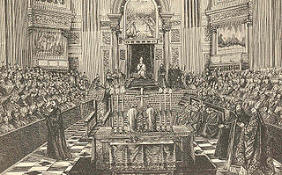
The Decrees Of The Vatican Council
THE DECREES OF THE VATICAN COUNCIL
To the Reader
IN presenting to the English reading public “The Decrees of the Vatican Council” we make no apology for calling it the “best book” and most valuable religious relic left to the twentieth century by the nineteenth. It is somewhat surprising that collections of the “hundred best books,” which usually begin with the Bible and generally include Marcus Aurelius, should give no place to the Acts of the General Councils; though mere literary works have done little beyond filling vacant hours, and these Acts have renewed the face of the earth.
Perhaps no General Council has been more naturally fitted than the Vatican Council to produce a masterpiece of religious thought and literature. No assembly of men since the time of CHRIST has ever been so representative of Christian and national thought. It is literally true to say that the Whitsun tongues of fire fell not on so many nations as were gathered together in Rome, July 18, 1870. Hardly one civilized or barbaric nation was unrepresented in the hierarchy. For the first time in the history of the Church every continent of the world sent its representative to bear witness to the truth. When we contrast the 537 bishops that voted in the last session with the 318 that voted at Nicea for the divinity of the Son of GOD and with the 274 that voted at Ephesus for the humanity of JESUS CHRIST, we begin to see the religious importance of the Vatican Council. We have to remember, moreover, that there were but five Western bishops at Nicea, and probably less at Ephesus, so that (numerically speaking) Nicea and Ephesus were representative merely of the East, and not wholly representative even of that, whereas the Old World and the New were fully represented at the Vatican.
Moreover, though the Acta of Nicea are almost wholly lost, it is not improbable that they, like the Acta of Ephesus, were quite as voluminous as those of the Vatican. Yet Nicea lasted only sixty-eight, Ephesus seventy, the Vatican 222 days. It is no exaggeration then to say that as compared with the two earlier Councils the Vatican was made up of twice as many bishops, representing ten times as many nations and spending thrice as much time over its decrees. Yet it is to Nicea and Ephesus we owe the two fundamental doctrines of the divinity and humanity of JESUS CHRIST. And men who, rightly, find no difficulty in accepting the two earlier councils, scruple to accept the last.
It would be tiresome so enumerate the amendments to the original draft of the Acta that were proposed and set aside. Eighty-six committee meetings (Congregationes Generales) were held. Of these forty-six dealt with the Constitution on Faith, and forty with the Constitution on the Church of CHRIST. These committee meetings lasted on an average four hours; and they were attended by the whole body of voters. The private work accompanying this formal activity may be left to the imagination. Yet the net result of this almost endless discussion is a document no larger than a page or two of a daily newspaper.
Catholic students of the Acta will not need reminding how great is the difference between the first Constitution and the second; for they are not of those who see in the Vatican Council merely a Roman cabal gathered together for the apotheosis of Ultramontanism. Such an unhistorical view of the Council is not consistent with an unbiased reading of the magnificent definitions which spring from the inter-relations of faith and reason. It is often the fate of great facts as of great truths to be praised or blamed for what is of least moment. In obedience to this law the Vatican Council has been welcomed or rejected for its decisions on the authority of the Holy See, though these decisions are hardly so momentous or fundamental as those on faith and reason.
Another law of history and of heresy is that Conciliar decisions instead of closing discussion often open, or at least precede, it. Arianism was at its height after the Nicene ὁμοουσίσς; the disputes on Grace followed the Council of Trent; Biblical criticism has reached its climax after the Vatican definition on Inspiration and Revelation. To such as find their lot cast amidst the intellectual unsettlement of the twentieth century it is consoling to realize that our Catholic fathers of the nineteenth century have left us a heritage of truth to which we have only to remain true in order to turn the mobile shifting flank of heresy. And this last will and testament of the past century, brief as a will and pregnant as a dying wish, holds within its formal words the principles whereby the errores et terrores sæculi, the falsehoods and fears of our age, may be met and withstood.
VINCENT McNABB, O.P.
Chronology
1864. Dec. 6. Pius IX first suggests a General Council.
1865. March. Commission of Direction appointed; Letters sent to various Bishops.
1866. Dec. 8. The Bishops are invited to meet in Rome, Dec. 8, 1867.
1867. June 26. Pius IX announces to the Bishops his intention to hold a Council.
1868. June 29. The Bull Æterni Patris summoning the Council for Dec. 8, 1869.
1869. Dec. 8. FIRST SESSION.
1870. April 24. THIRD SESSION: DOGMATIC CONSTITUTION ON THE CATHOLIC FAITH.
1870. July 18. FOURTH SESSION: DOGMATIC CONSTITUTION ON THE CHURCH OF CHRIST.
Copyright ©1999-2023 Wildfire Fellowship, Inc all rights reserved

 Keep Site Running
Keep Site Running